Mechanical Properties of Additively Manufactured Thermoplastic Polyurethane (TPU) Material Affected by Various Processing Parameters
Abstract
:1. Introduction
2. Materials and Methods
2.1. Test Specimens
2.2. Processing Parameters
2.2.1. Build Orientation
2.2.2. Post-Processing
2.2.3. Powder Mix Ratio
2.3. Tensile Test Setup
2.4. Scanning Electron Microscope (SEM)
2.5. Particle-Size Distribution (PSD)
2.6. Melt Flow Rate (MFR)
2.7. Differential Scanning Calorimetry (DSC)
3. Results and Discussion
3.1. Effect of Build Orientation
3.2. Effect of Post-Processing
3.3. Effect of Powder Mix Ratio
4. Conclusions
- The most significant way to improve the mechanical properties of printed parts is to increase the mix ratio of the new powder. The new powder has better particle quality and thermal properties, which are more effective for SLS processing.
- TPU specimens printed in flat and on-edge orientations exhibit similar superior mechanical properties. For the specimens printed in upright orientation, the tensile strength is about 40% lower and the deformability is about 60% lower compared to the other two orientations.
- Post-processing can substantially enhance the deformability of the specimens. For flat, on-edge and upright orientations, the deformability can be increased by 40.1%, 73.5% and 41.0%, respectively.
Author Contributions
Funding
Conflicts of Interest
References
- Bikas, H.; Stavropoulos, P.; Chryssolouris, G. Additive manufacturing methods and modeling approaches: A critical review. Int. J. Adv. Manuf. Technol. 2016, 83. [Google Scholar] [CrossRef] [Green Version]
- Hague, R.J.M. Unlocking the design potential of rapid manufacturing. In Rapid Manufacturing: An Industrial Revolution for the Digital Age; Wiley: Hoboken, NJ, USA, 2006; ISBN 0470016132. [Google Scholar] [CrossRef] [Green Version]
- Xie, Y.M.; Steven, G.P. A simple evolutionary procedure for structural optimization. Comput. Struct. 1993. [Google Scholar] [CrossRef]
- Xiong, Y.; Yao, S.; Zhao, Z.L.; Xie, Y.M. A new approach to eliminating enclosed voids in topology optimization for additive manufacturing. Addit. Manuf. 2020, 2. [Google Scholar] [CrossRef]
- Zegard, T.; Paulino, G.H. Bridging topology optimization and additive manufacturing. Struct. Multidiscip. Optim. 2016, 53. [Google Scholar] [CrossRef]
- Wang, X.; Xu, S.; Zhou, S.; Xu, W.; Leary, M.; Choong, P.; Qian, M.; Brandt, M.; Xie, Y.M. Topological design and additive manufacturing of porous metals for bone scaffolds and orthopaedic implants: A review. Biomaterials 2016, 83. [Google Scholar] [CrossRef]
- He, Y.; Cai, K.; Zhao, Z.L.; Xie, Y.M. Stochastic approaches to generating diverse and competitive structural designs in topology optimization. Finite Elem. Anal. Des. 2020, 173. [Google Scholar] [CrossRef]
- Bi, M.; Tran, P.; Xie, Y.M. Topology optimization of 3D continuum structures under geometric self-supporting constraint. Addit. Manuf. 2020, 36. [Google Scholar] [CrossRef]
- Calignano, F.; Manfredi, D.; Ambrosio, E.P.; Biamino, S.; Lombardi, M.; Atzeni, E.; Salmi, A.; Minetola, P.; Iuliano, L.; Fino, P. Overview on additive manufacturing technologies. Proc. IEEE 2017, 105. [Google Scholar] [CrossRef]
- Kruth, J.P.; Mercelis, P.; Van Vaerenbergh, J.; Froyen, L.; Rombouts, M. Binding mechanisms in selective laser sintering and selective laser melting. Rapid Prototyp. J. 2005, 11. [Google Scholar] [CrossRef] [Green Version]
- Agarwala, M.; Bourell, D.; Beaman, J.; Marcus, H.; Barlow, J. Direct selective laser sintering of metals. Rapid Prototyp. J. 1995. [Google Scholar] [CrossRef]
- Lamikiz, A.; Sánchez, J.A.; López de Lacalle, L.N.; Arana, J.L. Laser polishing of parts built up by selective laser sintering. Int. J. Mach. Tools Manuf. 2007, 47. [Google Scholar] [CrossRef]
- Barroqueiro, B.; Andrade-Campos, A.; Valente, R.A.F.; Neto, V. Metal additive manufacturing cycle in aerospace industry: A comprehensive review. J. Manuf. Mater. Process. 2019, 3, 52. [Google Scholar] [CrossRef] [Green Version]
- Berry, E.; Brown, J.M.; Connell, M.; Craven, C.M.; Efford, N.D.; Radjenovic, A.; Smith, M.A. Preliminary experience with medical applications of rapid prototyping by selective laser sintering. Med. Eng. Phys. 1997, 19. [Google Scholar] [CrossRef]
- Liu, Z.; Zhang, P.; Yan, M.; Xie, Y.M.; Huang, G. Additive manufacturing of specific ankle-foot orthoses for persons after stroke: A preliminary study based on gait analysis data. Math. Biosci. Eng. 2019, 16. [Google Scholar] [CrossRef] [PubMed]
- Mărieş, G.R.E.; Bandur, G.; Rusu, G. Influence of processing temperature on some mechanical-physical properties of thermoplastic polyurethane desmopan KA 8377 used for injection moulding of performance sport products. Chem. Bull. Politeh. Univ. (Timişoara) 2008, 53, 131–134. [Google Scholar]
- Aurilia, M.; Piscitelli, F.; Sorrentino, L.; Lavorgna, M.; Iannace, S. Detailed analysis of dynamic mechanical properties of TPU nanocomposite: The role of the interfaces. Eur. Polym. J. 2011, 47. [Google Scholar] [CrossRef]
- Ma, H.; Yang, Y. Rheology, morphology and mechanical properties of compatibilized poly(vinylidene fluoride) (PVDF)/thermoplastic polyurethane (TPU) blends. Polym. Test. 2008, 27, 441–446. [Google Scholar] [CrossRef]
- Li, W.; Liu, J.; Hao, C.; Jiang, K.; Xu, D.; Wang, D. Interaction of thermoplastic polyurethane with polyamide 1212 and its influence on the thermal and mechanical properties of TPU/PA1212 blends. Polym. Eng. Sci. 2008, 48. [Google Scholar] [CrossRef]
- Mi, H.-Y.; Salick, M.R.; Jing, X.; Jacques, B.R.; Crone, W.C.; Peng, X.-F.; Turng, L.-S. Characterization of thermoplastic polyurethane/polylactic acid (TPU/PLA) tissue engineering scaffolds fabricated by microcellular injection molding. Mater. Sci. Eng. C 2013, 33, 4767–4776. [Google Scholar] [CrossRef] [Green Version]
- Poomali; Siddaramaiah; Suresha, B.; Lee, J.-H. Mechanical and three-body abrasive wear behaviour of PMMA/TPU blends. Mater. Sci. Eng. A 2008, 492, 486–490. [Google Scholar] [CrossRef]
- Feng, F.; Ye, L. Morphologies and mechanical properties of polylactide/thermoplastic polyurethane elastomer blends. J. Appl. Polym. Sci. 2011, 119, 2778–2783. [Google Scholar] [CrossRef]
- Lu, Q.W.; Macosko, C.W.; Horrion, J. Compatibilized blends of thermoplastic polyurethane (TPU) and polypropylene. Macromol. Symp. 2003, 198, 221–232. [Google Scholar] [CrossRef]
- Lee, H.; Eom, R.I.; Lee, Y. Evaluation of the mechanical properties of porous thermoplastic polyurethane obtained by 3D printing for protective gear. Adv. Mater. Sci. Eng. 2019, 2019. [Google Scholar] [CrossRef] [Green Version]
- Bates, S.R.G.; Farrow, I.R.; Trask, R.S. 3D printed polyurethane honeycombs for repeated tailored energy absorption. Mater. Des. 2016. [Google Scholar] [CrossRef] [Green Version]
- Bates, S.R.G.; Farrow, I.R.; Trask, R.S. 3D printed elastic honeycombs with graded density for tailorable energy absorption. In Active and Passive Smart Structures and Integrated Systems; International Society for Optics and Photonics: Bellingham, WA, USA, 2016. [Google Scholar] [CrossRef] [Green Version]
- Scarpello, M.L.; Kazani, I.; Hertleer, C.; Rogier, H.; Vande Ginste, D. Stability and efficiency of screen-printed wearable and washable antennas. IEEE Antennas Wirel. Propag. Lett. 2012. [Google Scholar] [CrossRef]
- Li, Y.; Zhou, B.; Zheng, G.; Liu, X.; Li, T.; Yan, C.; Cheng, C.; Dai, K.; Liu, C.; Shen, C.; et al. Continuously prepared highly conductive and stretchable SWNT/MWNT synergistically composited electrospun thermoplastic polyurethane yarns for wearable sensing. J. Mater. Chem. C 2018, 6, 2258–2269. [Google Scholar] [CrossRef]
- Dadbakhsh, S.; Verbelen, L.; Vandeputte, T.; Strobbe, D.; Van Puyvelde, P.; Kruth, J.P. Effect of powder size and shape on the SLS processability and mechanical properties of a TPU elastomer. Phys. Procedia 2016. [Google Scholar] [CrossRef] [Green Version]
- Gan, X.; Wang, J.; Fei, G.; Xia, H. Selective laser sintering of polyurethane elastomers. Polym. Mater. Sci. Eng. 2019, 35. [Google Scholar] [CrossRef]
- Verbelen, L.; Dadbakhsh, S.; Van den Eynde, M.; Strobbe, D.; Kruth, J.P.; Goderis, B.; Van Puyvelde, P. Analysis of the material properties involved in laser sintering of thermoplastic polyurethane. Addit. Manuf. 2017, 15. [Google Scholar] [CrossRef]
- Yuan, S.; Shen, F.; Bai, J.; Chua, C.K.; Wei, J.; Zhou, K. 3D soft auxetic lattice structures fabricated by selective laser sintering: TPU powder evaluation and process optimization. Mater. Des. 2017, 120. [Google Scholar] [CrossRef]
- Barba, D.; Alabort, C.; Tang, Y.T.; Viscasillas, M.J.; Reed, R.C.; Alabort, E. On the size and orientation effect in additive manufactured Ti-6Al-4V. Mater. Des. 2020, 186. [Google Scholar] [CrossRef]
- Chacón, J.M.; Caminero, M.A.; García-Plaza, E.; Núñez, P.J. Additive manufacturing of PLA structures using fused deposition modelling: Effect of process parameters on mechanical properties and their optimal selection. Mater. Des. 2017, 124. [Google Scholar] [CrossRef]
- Ramos, J.A.; Bourell, D.L. Modeling of surface roughness enhancement of indirect-SLS metal parts by laser surface polishing. Proc. TMS Fall Meet. 2002, 191–202. [Google Scholar] [CrossRef]
- Boualleg, A. Investigations on Post-Processing of 3D Printed Thermoplastic Polyurethane (TPU) Surface; Halmstad University: Halmstad, Sweden, 2019. [Google Scholar]
- Allen, K.W. Polymer Surface Modification: Relevance to Adhesion; John Wiley & Sons, Ltd.: Hoboken, NJ, USA, 1997; Volume 42. [Google Scholar] [CrossRef]
- Molitor, P.; Barron, V.; Young, T. Surface treatment of titanium for adhesive bonding to polymer composites: A review. Int. J. Adhes. Adhes. 2001, 21. [Google Scholar] [CrossRef]
- Kumar, S. Selective laser sintering: A Qualitative and objective approach. JOM 2003, 55. [Google Scholar] [CrossRef]
- International Organization for Standardization. ISO 37: Rubber, Vulcanized or Thermoplastic—Determination of Tensile Stress-Strain Properties. Available online: https://www.iso.org/standard/68116.html (accessed on 20 October 2019).
- Cheng, J.; Lao, S.; Nguyen, K.; Ho, W.; Cummings, A.; Koo, J. SLS processing studies of nylon 11 nanocomposites. In Proceedings of the 16th Solid Freeform Fabrication Symposium, SFF, Austin, TX, USA, 6–8 August 2005. [Google Scholar]
- Schmid, M.; Wegener, K. Additive Manufacturing: Polymers applicable for laser sintering (LS). Proc. Eng. 2016, 149. [Google Scholar] [CrossRef] [Green Version]
- Plummer, K.; Vasquez, M.; Majewski, C.; Hopkinson, N. Study into the recyclability of a thermoplastic polyurethane powder for use in laser sintering. Proc. Inst. Mech. Eng. Part B J. Eng. Manuf. 2012, 226, 1127–1135. [Google Scholar] [CrossRef]
- ASTM International. ASTM D1238-20: Standard Test Method for Melt Flow Rates of Thermoplastics by Extrusion Plastometer. Available online: http://www.astm.org/cgi-bin/resolver.cgi?D1238 (accessed on 6 November 2020).

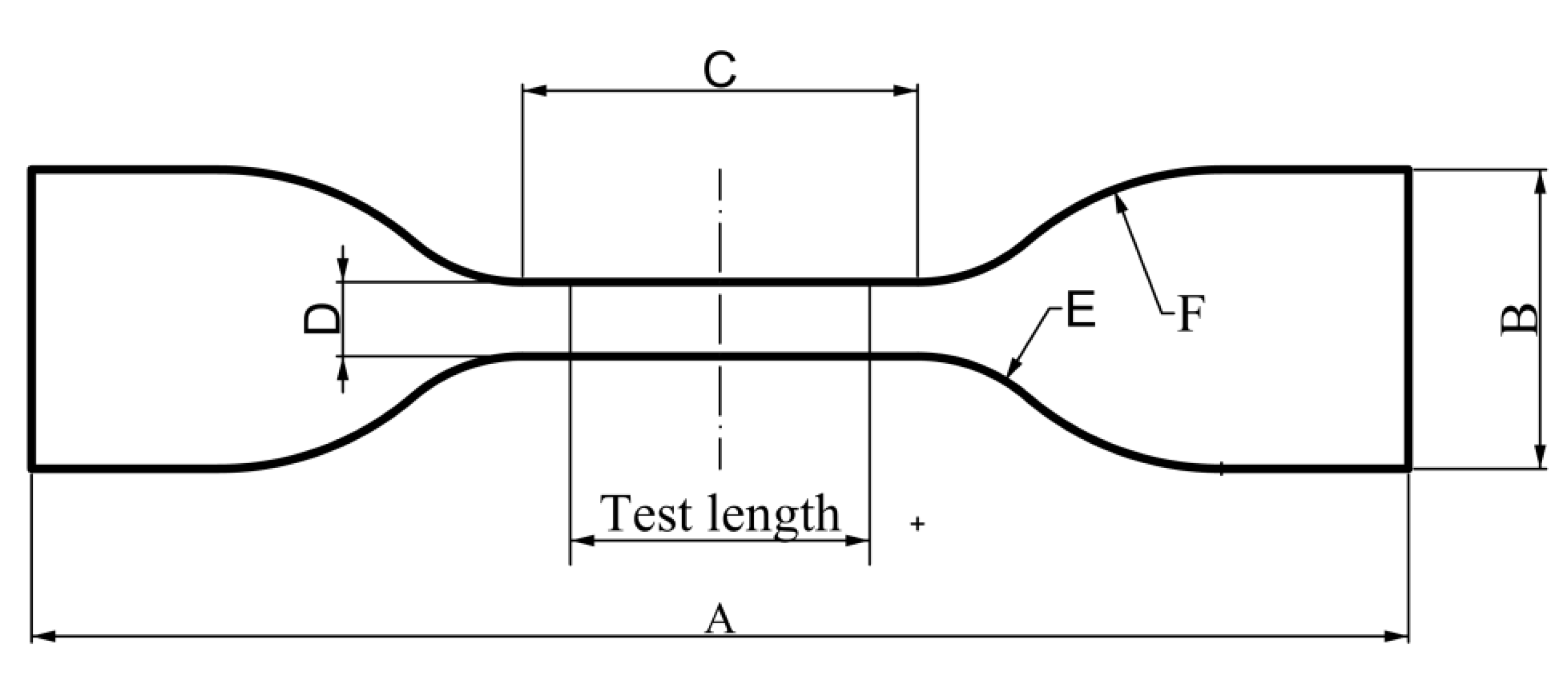
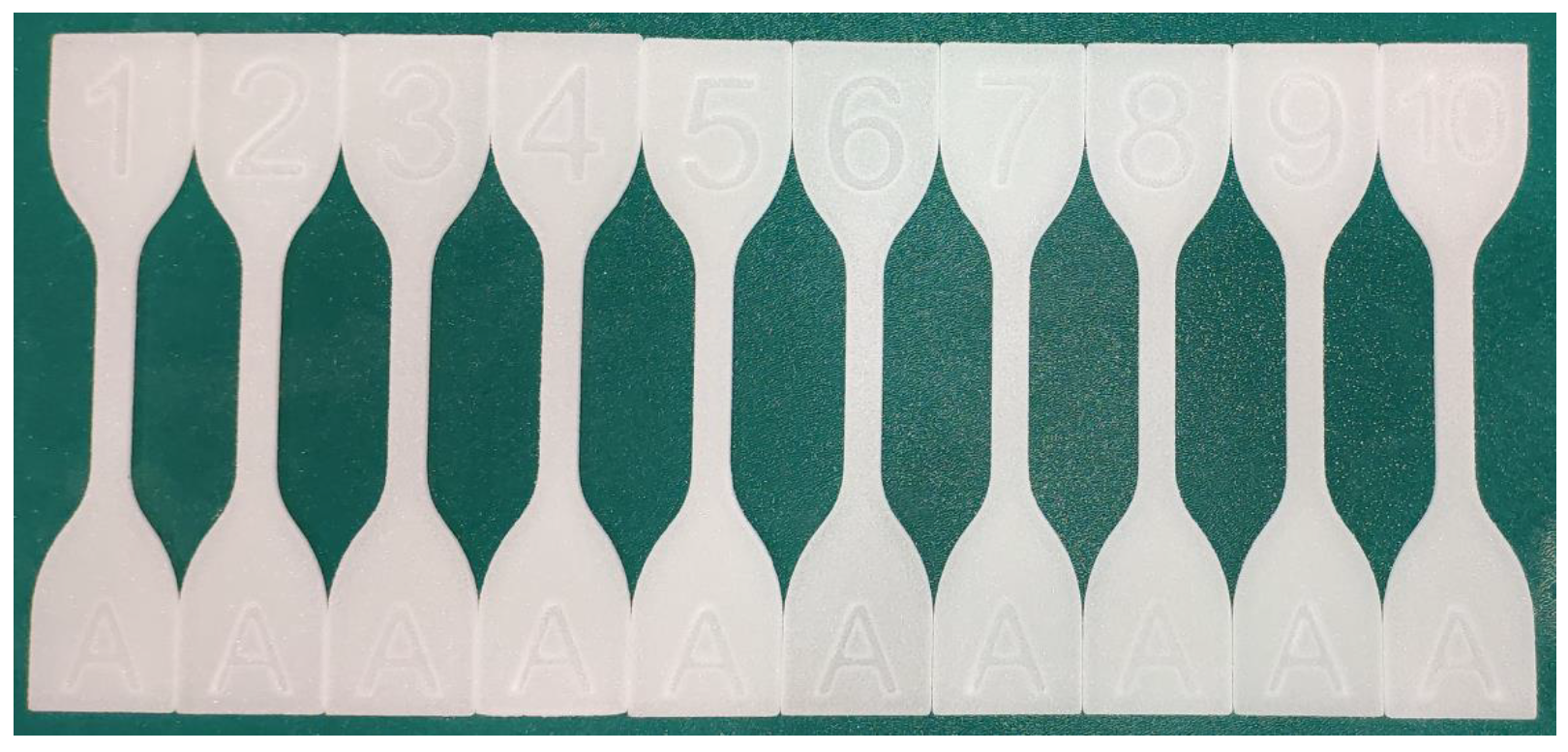
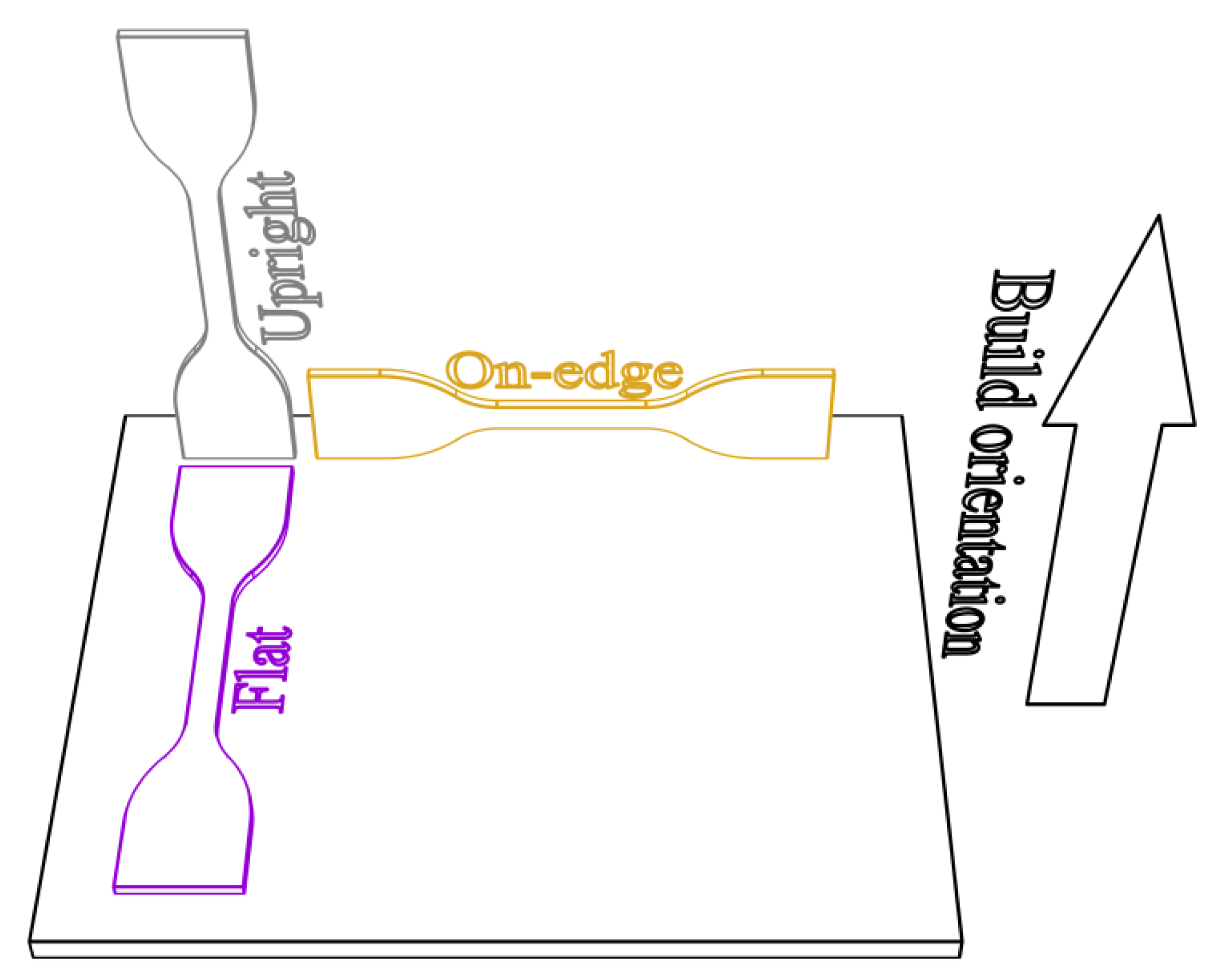



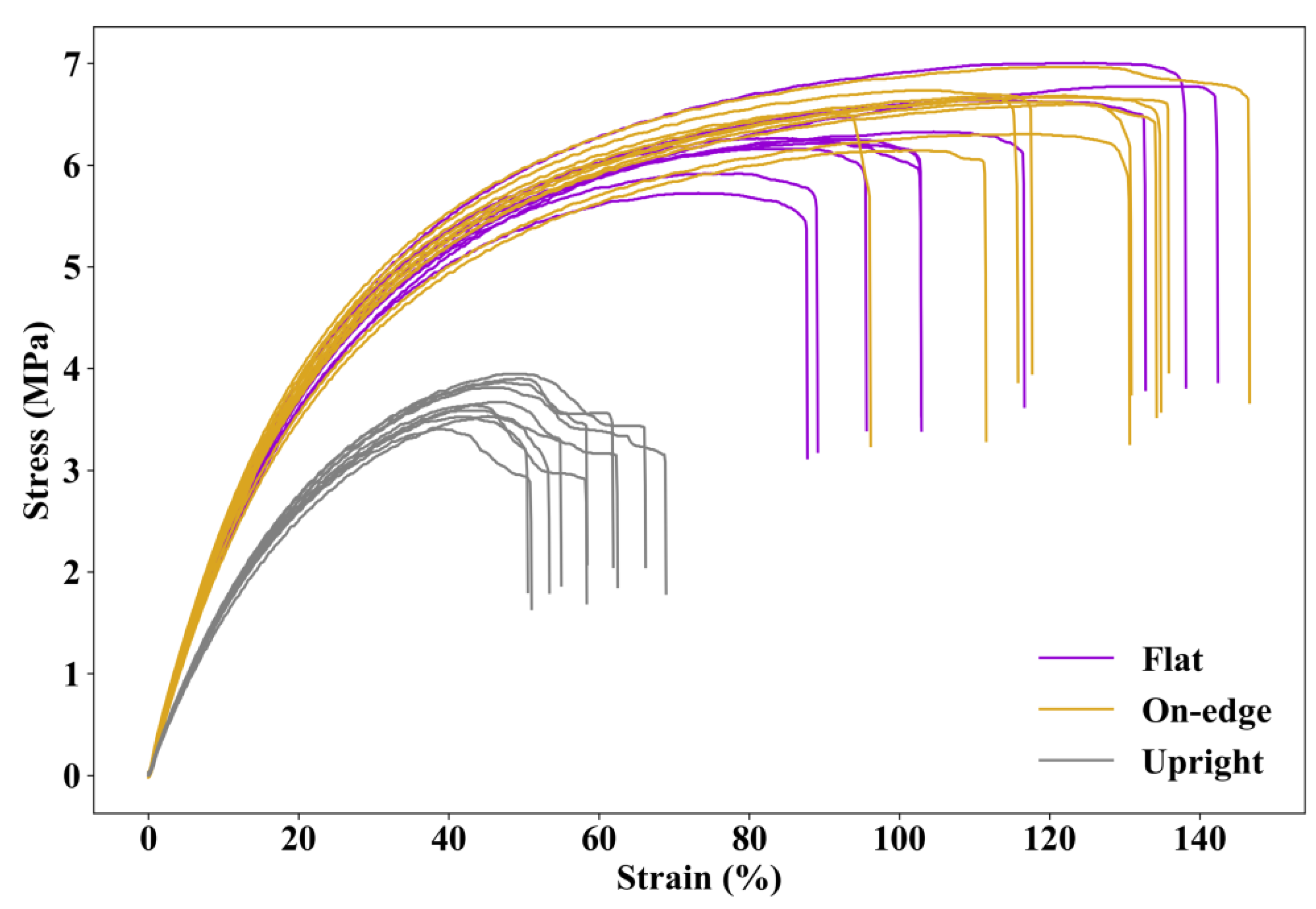



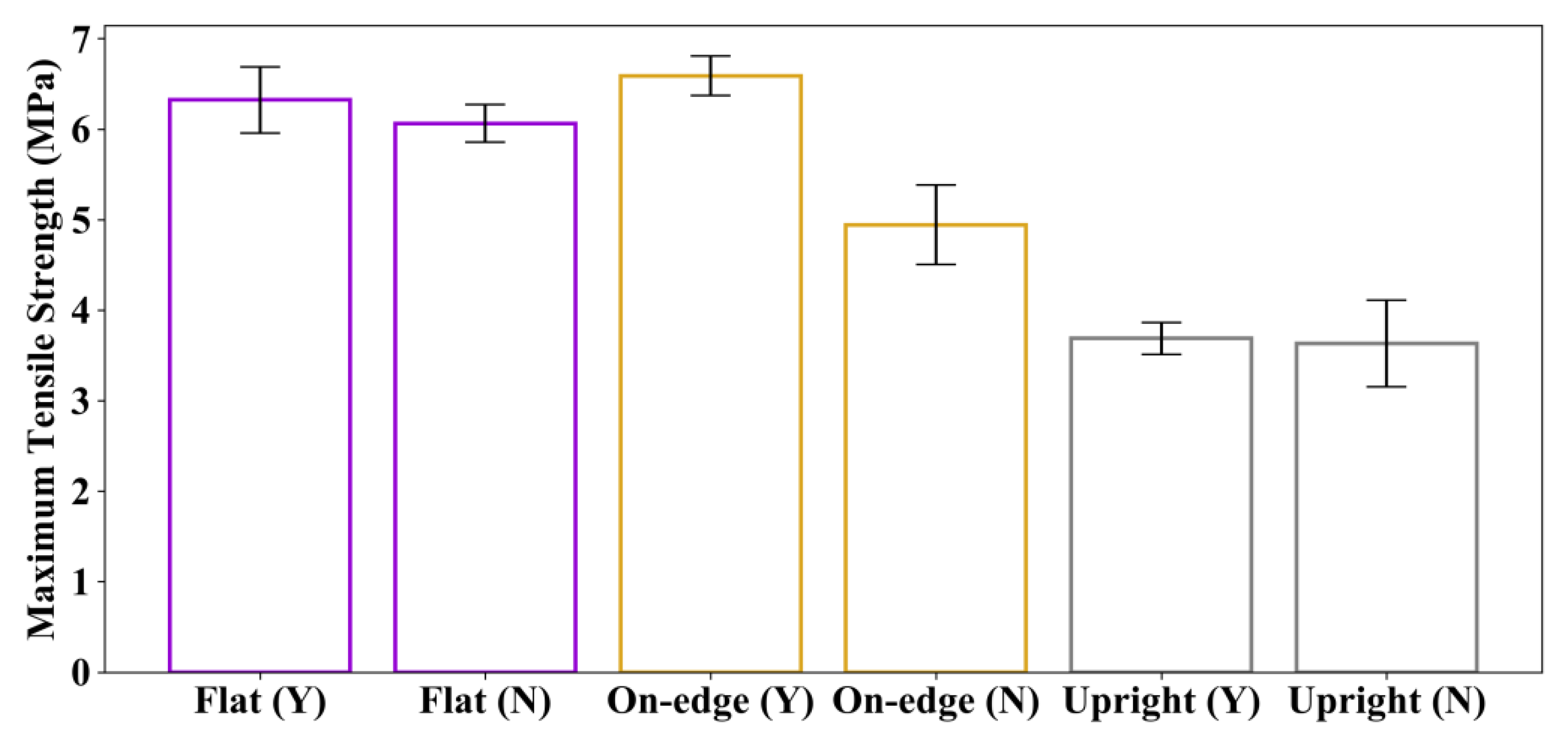

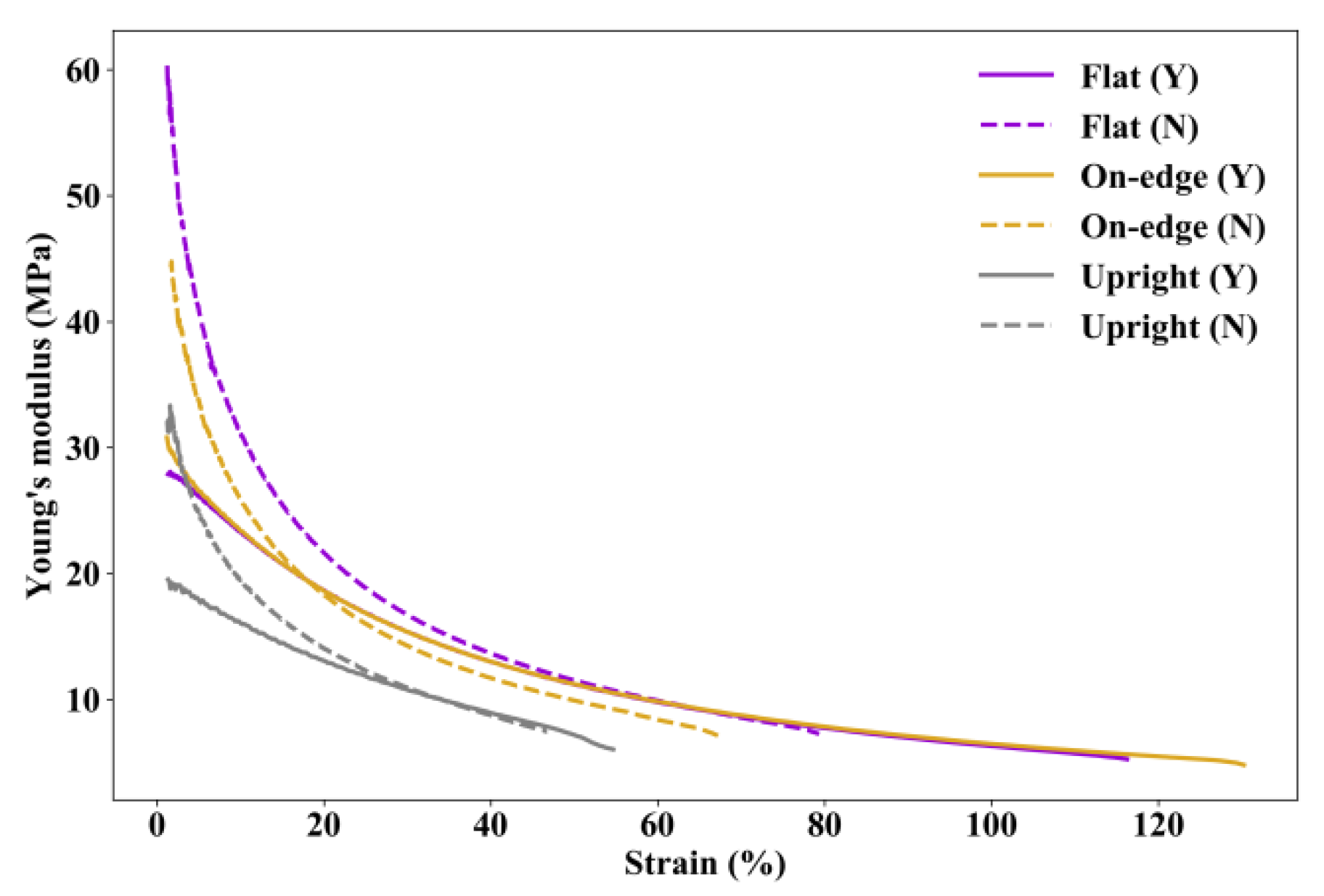
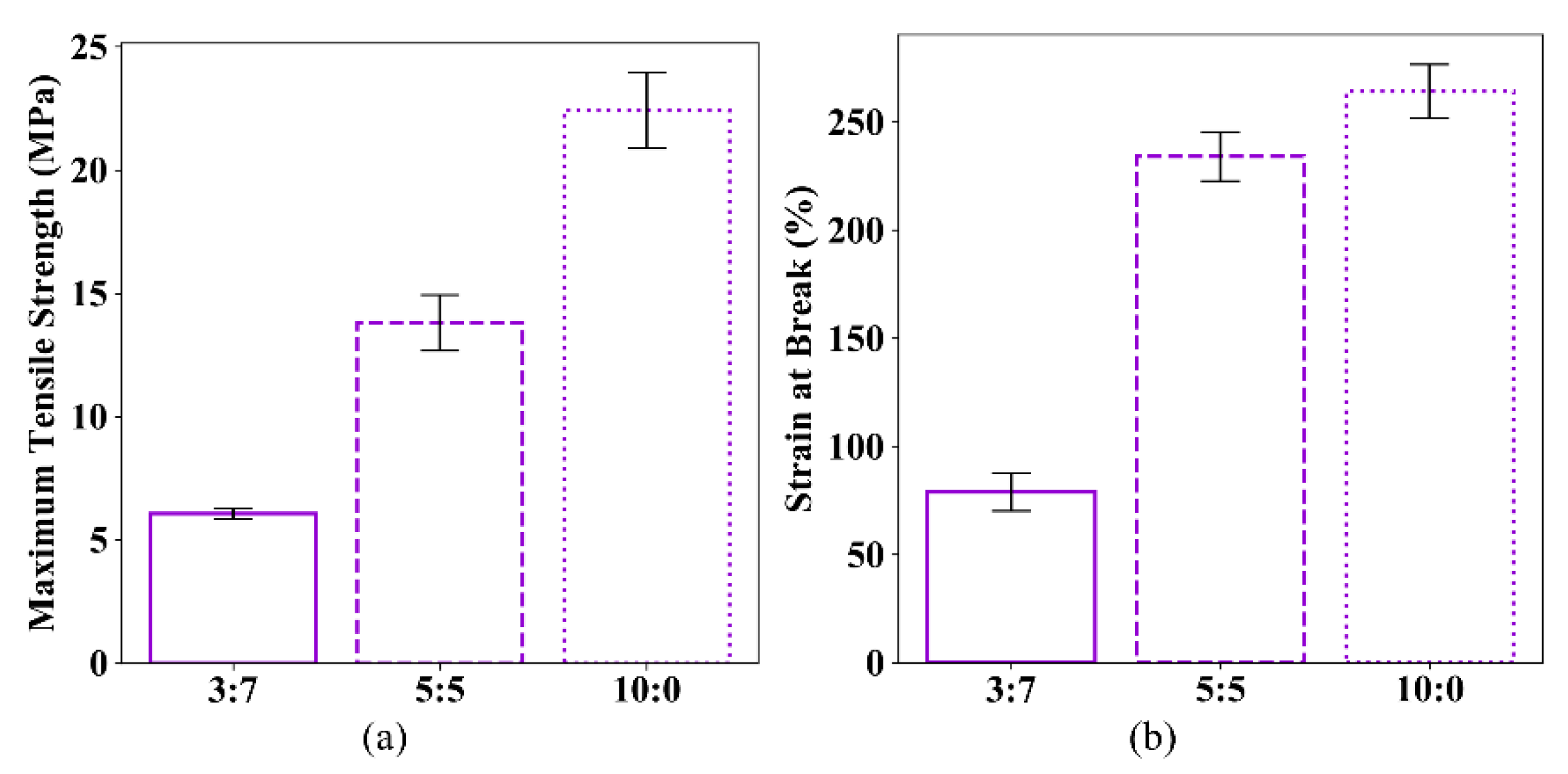
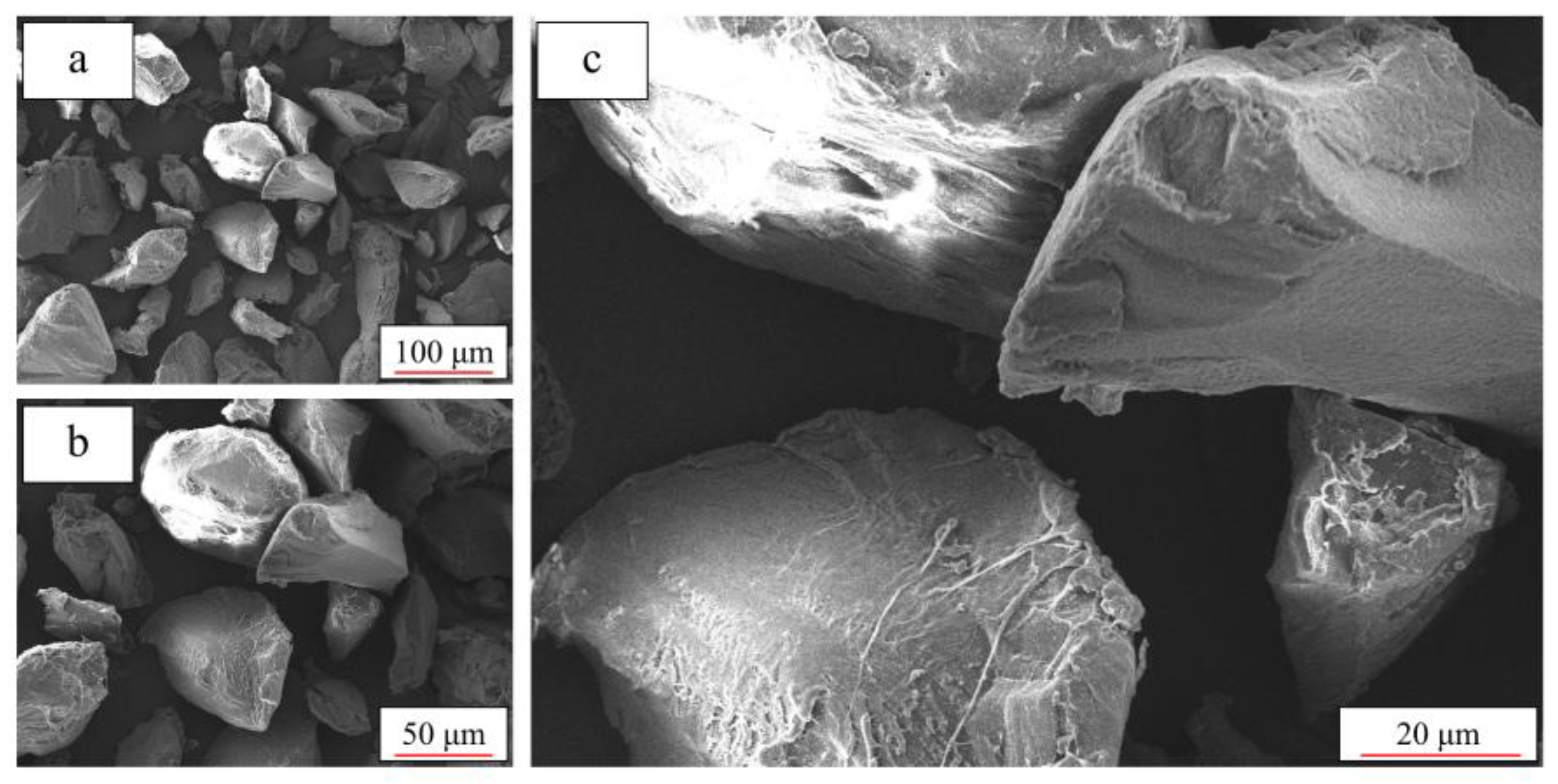


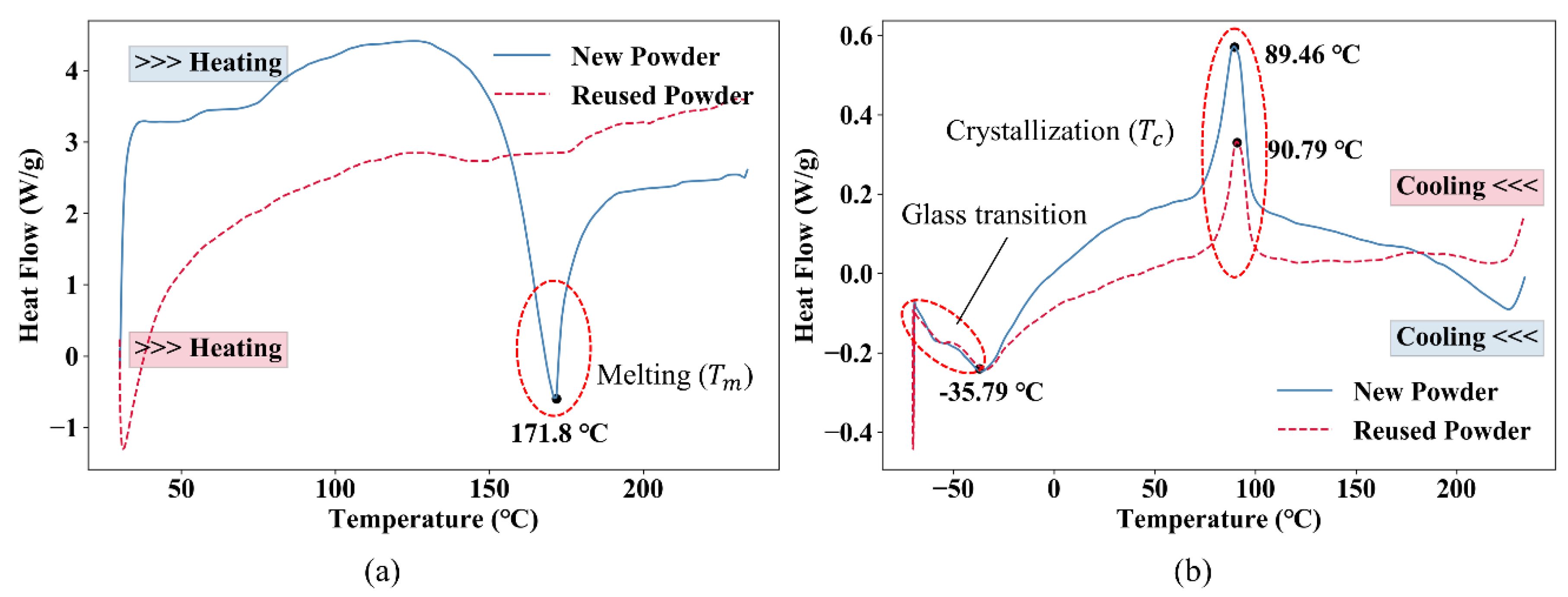
| Dimension | Value (mm) |
|---|---|
| entry 1 | data |
| A. Overall length (minimum) | 115 |
| B. Width of ends | 25 ± 1 |
| C. Length of the narrow portion | 33 ± 2 |
| D. Width of the narrow portion | 6.2 ± 0.2 |
| E. Transition radius outside | 14 ± 1 |
| F. Transition radius inside | 25 ± 2 |
| Test length | 25 ± 0.5 |
| Thickness | 2 ± 0.2 |
| Parameters | Value |
|---|---|
| Build orientation | Flat, on-edge, upright |
| Post-processing method | Chemical treatment, none |
| Powder mix ratio | |
| (new powder: reused powder) | 3:7; 5:5; 10:0 |
| Set Number | Build Orientation | Post-Processing Method | Powder Mix Ratio (New Powder: Reused Powder) |
|---|---|---|---|
| 1 | Flat | Chemical treatment | 3:7 |
| 2 | On-edge | Chemical treatment | 3:7 |
| 3 | Upright | Chemical treatment | 3:7 |
| 4 | Flat | None | 3:7 |
| 5 | On-edge | None | 3:7 |
| 6 | Upright | None | 3:7 |
| 7 | Flat | None | 5:5 |
| 8 | Flat | None | 10:0 |
| Set Number | Build Orientation | ||
|---|---|---|---|
| 1 | Flat | 6.32 | 110.46 |
| 2 | On-edge | 6.65 | 125.27 |
| 3 | Upright | 3.69 | 58.43 |
| Set | Build Orientation | Post-Processing Method | ||
|---|---|---|---|---|
| 1 | Flat | Chemical treatment | 6.32 | 110.46 |
| 2 | On-edge | Chemical treatment | 6.65 | 125.27 |
| 3 | Upright | Chemical treatment | 3.69 | 58.43 |
| 4 | Flat | None | 6.06 | 78.81 |
| 5 | On-edge | None | 4.94 | 72.20 |
| 6 | Upright | None | 3.63 | 41.45 |
| Set Number | Mix Ratio (New Powder: Reused Powder) | ||
|---|---|---|---|
| 4 | 3: 7 | 6.06 | 78.81 |
| 7 | 5: 5 | 13.81 | 233.91 |
| 8 | 10: 0 | 22.42 | 264.07 |
Publisher’s Note: MDPI stays neutral with regard to jurisdictional claims in published maps and institutional affiliations. |
© 2020 by the authors. Licensee MDPI, Basel, Switzerland. This article is an open access article distributed under the terms and conditions of the Creative Commons Attribution (CC BY) license (http://creativecommons.org/licenses/by/4.0/).
Share and Cite
Xu, T.; Shen, W.; Lin, X.; Xie, Y.M. Mechanical Properties of Additively Manufactured Thermoplastic Polyurethane (TPU) Material Affected by Various Processing Parameters. Polymers 2020, 12, 3010. https://doi.org/10.3390/polym12123010
Xu T, Shen W, Lin X, Xie YM. Mechanical Properties of Additively Manufactured Thermoplastic Polyurethane (TPU) Material Affected by Various Processing Parameters. Polymers. 2020; 12(12):3010. https://doi.org/10.3390/polym12123010
Chicago/Turabian StyleXu, Tao, Wei Shen, Xiaoshan Lin, and Yi Min Xie. 2020. "Mechanical Properties of Additively Manufactured Thermoplastic Polyurethane (TPU) Material Affected by Various Processing Parameters" Polymers 12, no. 12: 3010. https://doi.org/10.3390/polym12123010






